The cathedral of Notre-Dame de Paris always makes a powerful impression on me. Doesn’t it look like a vessel in the shape of a cross set on the Île de la Cité? The sanctuary is considered a leading example of French Gothic architecture. There’s so much to say about its monumental dimensions. Its fine stained-glass windows. The audacious flying buttresses. The rich sculptures and statues! Standing above the banks of the River Seine, the cathedral played and still plays an integral part in the history of Paris and France, from its construction in the 12th century up to now.
Please note: this article was written before the great 2019 fire of the cathedral.
Get the ebook Notre-Dame de Paris – A Photographic Journey!
👉 Buy and download your copy here! 👈
- 80 inspiring photos taken by Pierre inside and around Notre-Dame
- 108 pages
Notre-Dame de Paris: a bit of History
The cathedral of Notre-Dame de Paris occupies the site where several sanctuaries have stood since the Gallo-Roman era:
- a temple dedicated to Jupiter,
- a large basilica from the 4th century,
- and a Carolingian cathedral in the 9th century.

One of the first Gothic cathedrals
In 1160, under the reign of King Louis VII, Paris bishop Maurice de Sully (1105/1120?-1196) decided on constructing a much larger sanctuary. It had to accommodate the population growth of Paris.
Notre-Dame was built in a new style at the time, later known as ‘Gothic architecture’. Already a few sanctuaries had been built (or were being built) in that style around Paris:
- the abbey church of Saint-Denis, and
- the cathedrals of Noyon, Laon and Sens.
In 1163, Pope Alexandre III laid the foundation stone in the presence of the King. Most of the work was executed under the direction of Maurice de Sully and his successor, Odon de Sully:
- the choir and its two ambulatories (1163-1182),
- the four last spans of the nave, the side aisles and the galleries (1190-1225),
- and the western façade and its two towers (1225-1250)

In the 13th century
By the reign of Saint-Louis in the mid-13th century, the cathedral was completed and operational. For the next couple of centuries, the cathedral underwent a few alterations as well as works of embellishment and maintenance, for instance:
- the main portals of the façade of the Romanesque style were rebuilt between 1250 and 1268.
- the transept was extended to the north and the south with the addition of the great rose windows.
- a rood-screen was added between the nave and the choir.
- the chapels in the ambulatory date back to 1296.
- magnificent flying buttresses of the chevet were added in the first half of the 14th century.
- the choir screen was redesigned in the 14th century.
From the Renaissance to Louis XIV
The interior decoration was first modified in the Renaissance era. At that time, many considered Gothic architecture as being barbaric and old-fashioned. Giant tapestries and wallpapers covered the walls and arcades of the church.
Under the reign of Louis XIV in 1699, the rood-screen was demolished, and the choir re-organised. New stalls were designed, and a wrought-iron choir screen was added. In 1756 the canon had a few stained-glass windows dating from the Middle Ages removed to get more light inside.

Notre-Dame during the French Revolution
During the French Revolution, the Revolutionaries destroyed many symbols evoking the Old Regime. They beheaded and removed the statues of the kings of Judah (mistaken for the kings of France) while the relics were vandalised. Most of the altars were destroyed, and the furnishing was sold. Desecrated, Notre-Dame became a Temple of Reason. A festival devoted to the goddess of Reason was celebrated inside on 10 November 1793.
Then the sanctuary was transformed into a storehouse.
Notre-Dame during the 19th century
The Catholics got their cathedral back in 1802. In December 1804, Notre-Dame welcomed the coronation ceremony of Napoleon Bonaparte in the presence of Pope Pius VII.

In the 19th century, the campaign to protect Gothic architecture in France, instigated by Victor Hugo through his novel “The Hunchback of Notre-Dame” in 1831, led to a vast programme of restoration, replacements and new creations.

By 1864, the French architect Eugène Viollet-le-Duc completed the restoration work of Notre-Dame Cathedral, which focused essentially on the following:
- the statuary,
- rebuilding a spire at the crossing of the transept,
- the stained-glass windows,
- and the new sacristy.
Viollet-le-Duc added chimeras on the Western façade, which did not exist during the Middle Ages.
In the 1860s, the Parvis of Notre-Dame was enlarged by Baron Haussmann with the clearing of many houses and buildings. An extended renovation took place in the 1990s and 2000s to restore Notre-Dame to its former glory.
In the 20th century
In 2013 Notre-Dame celebrated its 850th anniversary by installing 8 new bells inside the North Tower and renovating the great organ.
On April 15. 2019 a fire broke out on the roofs and spread rapidly across the building (see below). Within a few hours, the spire and roofs sadly collapsed. Fortunately, the overall structure of the church didn’t disintegrate, but the restoration task is immense and will take at least five years.
Historical events which took place in Notre-Dame
- 1185: Heraclius of Caesarea calls for the Third Crusade from Notre-Dame Cathedral.
- 1239: The Crown of Thorns is brought into the cathedral by King Saint-Louis to be kept during the construction of the Sainte-Chapelle.
- 1302: Philip the Fair opens the first States-General.
- 16 December 1431: Henry VI of England is crowned King of France.
- 24 April 1558: Mary, Queen of Scots, is married to the Dauphin Francis (later Francis II of France), son of King Henry II of France.
- 18 August 1572: Henry of Navarre (later Henry IV) marries Margaret of Valois. The marriage occurs in the cathedral for Margaret and on the parvis for Henry IV as he is Protestant. The wedding takes place six days before the St. Bartholomew’s Day massacre.

From the French Revolution to the 21st Century
- 10 November 1793: the Festival of Reason is held inside the cathedral.
- 2 December 1804: the coronation ceremony of Napoleon I and his wife Joséphine, in the presence of Pope Pius VII.
- 1831: Victor Hugo publishes the novel The Hunchback of Notre-Dame.
- 30 January 1853: Napoleon III is married to Eugénie.
- 16 May 1920: Joan of Arc is canonised.
- 26 August 1944: a mass takes place in the cathedral to celebrate the liberation of Paris in the presence of General De Gaulle and General Leclerc.
- 12 November 1970: funeral service of General Charles de Gaulle.
- 1974: funeral service of Georges Pompidou.
- 31 May 1980: Pope John Paul II celebrates Mass on the parvis of the cathedral.
- January 1996: funeral service of François Mitterrand.
- 1997: second visit of Pope John-Paul II.
- 2013: The 850th anniversary of Notre-Dame.
- 15 April 2019: great fire and partial destruction of Notre-Dame.
- 8 December 2024: scheduled date for the reopening of the restored cathedral.
The Great Fire of Notre Dame cathedral
The great fire of Notre Dame occurred on the 15th of April 2019.
![15 April 2019 at 7.32pm © Cilcée - licence [CC BY-SA 4.0] from Wikimedia Commons](https://frenchmoments.eu/wp-content/uploads/2012/11/Notre-Dame-de-Paris-Incendie-15-avril-2019-19h32-©-Cilcée-licence-CC-BY-SA-4.0-from-Wikimedia-Commons.jpg)
![Fire of Notre-Dame at 8.06pm © GodefroyParis - licence [CC BY-SA 4.0] from Wikimedia Commons](https://frenchmoments.eu/wp-content/uploads/2012/11/Fire-of-Notre-Dame-20h06-©-GodefroyParis-licence-CC-BY-SA-4.0-from-Wikimedia-Commons.jpg)
The firefighters’ fight to save Notre-Dame
More than 400 firefighters worked to keep the fire under control unsuccessfully.
Just after a human chain formed to remove precious objects to safety, the spire collapsed, creating such a draft that it spread the fire to the attic.
![Notre-Dame de Paris Fire © Antoninnnnn - licence [CC BY-SA 4.0] from Wikimedia Commons](https://frenchmoments.eu/wp-content/uploads/2012/11/Notre-Dame-Fire-©-Antoninnnnn-licence-CC-BY-SA-4.0-from-Wikimedia-Commons.jpg)
The cathedral narrowly escaped destruction. Indeed if the vaulting had collapsed during the fire, the nave walls wouldn’t have been able to stand. In turn, they would have collapsed into the nave.
However, the fire also reached the north tower, which supported eight heavy bells.
Had they fallen, it would have probably led to the collapse of the towers and consequently of the entire edifice.
Therefore firefighters successfully managed to extinct the fire by 9.45 pm.
![Notre-Dame de Paris on 19 April 2019 © Arthur Weidmann - licence [CC BY-SA 2.0] from Wikimedia Commons](https://frenchmoments.eu/wp-content/uploads/2012/11/Notre-Dame-de-Paris-19-avril-2019-©-Arthur-Weidmann-licence-CC-BY-SA-2.0-from-Wikimedia-Commons.jpg)
What about the cathedral’s relics?
Notre-Dame Cathedral is famous for its relics. They include the crown of thorns said to be the one Jesus wore on the day of his crucifixion, a purported piece of Jesus’ cross, the Tunic of St. Louis, as well as a significant number of religious artworks.
Were the stunning medieval stained-glass windows destroyed?
Good news! They were not! Although lead joints in some 19th-century windows melted, the three major rose windows from the 13th century were spared.
When Notre-Dame Cathedral rebuilt?
French President Emmanuel Macron vowed to restore the cathedral by 2024, although, with the 2020 pandemic outbreak, the deadline looked exceptionally tight. Fundraising was organised after the fire with over €1 billion in pledges.
![Notre-Dame de Paris after the fire © Jeanne Menjoulet - licence [CC BY 2.0] from Wikimedia Commons](https://frenchmoments.eu/wp-content/uploads/2012/11/Notre-Dame-after-the-fire-©-Jeanne-Menjoulet-licence-CC-BY-2.0-from-Wikimedia-Commons.jpg)
It was also uncertain that the timber roof framing, dating from the Middle Ages, would be restored identically or include other materials.
For example, the 1836 restoration of the roof framing of Chartres Cathedral included wrought-iron trusses and copper sheeting instead of wood.
![Notre-Dame de Paris - Roof after the Great Fire © Joëlle Lévy - licence [CC BY-SA 4.0] from Wikimedia Commons](https://frenchmoments.eu/wp-content/uploads/2012/11/Notre-Dame-Roof-after-Fire-©-Joëlle-Lévy-licence-CC-BY-SA-4.0-from-Wikimedia-Commons.jpg)
The prognosis is as follows:
- the cathedral will be returned to worship by Easter 2024
- the (identical) spire will be erected in time for the Summer Olympics in Paris (2024)
- the roofing and other exterior work will continue after the Olympics.
Progress of the restoration work
Below, I have included a selection of videos showing the progress of the work.
Please come back to this page occasionally to discover new videos.
Notre Dame Cathedral devastated by fire in Paris
16 April 2019
The following day of the fire, a report by CBS This Morning.
A look inside the Restoration of Notre Dame Cathedral
20 March 2020
A report by Science Magazine
The people tirelessly restoring Notre-Dame to its former glory
10 July 2020
A report by France 24
200 tons of scaffolding removed from Notre Dame Cathedral
27 November 2020
A report by CBS News
Inside Notre Dame Cathedral nearly two years after a devastating fire
17 February 2021
A report by Good Morning America
Rebuilding Notre-Dame
7 April 2021
A report by CNN 10
Reconstruction continues at the Cathedral of Notre Dame 4 years after the fire
11 April 2023
A report by 60 minutes
La flèche de Notre-Dame de Paris a retrouvé sa croix, il ne manque que le coq
7 December 2023
A report by the Huffington Post
Stunning Timelapse of Rebuilt Notre-Dame Spire Reveal
19 March 2024
A video by On Demand News
The great fire of Notre-Dame: a blessing in Disguise?
The catastrophe has opened a window of opportunity to understand the cathedral better.
Notre-Dame has a lot of things to tell and has already started to deliver its secrets.
A rock-solid edifice
First, the church enjoys an incredible solidity. The medieval vaults have perfectly played their roles of firewall protection. With the collapse of the spire into the crossing, only 15% of the ceiling has been touched.
In fact, because of the big holes in the vaults, the cathedral unveils itself like never before.
We now know the thickness of the vaults – one thing we did not know before.
We’ve learnt how the stones were cut and put together during the cathedral’s construction in the Middle Ages.
Today’s survey leads to a better understanding of the vault’s behaviour. And this will benefit many other buildings, including bridges, tunnels, and supporting walls.
To get an idea, some historic buildings have been closed to the public because of the risk of falling stones. No surprise, the knowledge gained in studying Notre-Dame today will help restore other monuments.
It’s going to be a luminous cathedral
With the restoration work to come, the general curator of relics predicts that Notre-Dame will “change colour”. Until the fire, the cathedral was dusty and filthy. The work will be the opportunity to render it to its former glory, just like the spectacular restoration of the church of Saint-Germain-des-Près. For instance, cleaning stained-glass windows will bring much more light than before.
I can’t wait to revisit the interior in 4-5 years.
Medieval discoveries
Survey excavations were done on the site before installing the 75 m-tall crane, which led to the discovery of the medieval quay. The riverbank was raised in the 12th century with a wall to help unload the materials used to build Notre Dame.
Controversial Plan to Renovate Notre-Dame Cathedral
On December 9, 2021, France’s National Heritage and Architecture Commission approved a plan to renovate the interior of the historic Notre-Dame Cathedral.
And this plan to renovate Paris’ cathedral is very controversial. Indeed, conservative critics have opposed the new proposal, which aims to make the Paris landmark an “even more beautiful and welcoming” place for visitors.
The proposal, which was put forth by the Diocese of Paris, calls for modernising the cathedral’s interior.
Critics, however, say that the renovations will reduce the standing of the historic building into a theme park. Yes, the cathedral would turn into an “ecclesiastical Disneyland”.
But what is behind the plans?
Are they so controversial, or will they bring something new to Notre Dame?
Major changes include:
- the entrance to the cathedral will take place through the grand central doors
- the addition of softer mood lighting hung at head level
- new light projections, which will project short Bible quotes in multiple languages onto the cathedral’s walls
- the rearrangement of altars and other items to free up space for people to move around.
- the removal of a group of little-used 19th-century confessionals to the ground floor to create a space for displays of modern and contemporary art.
- new benches to replace the traditional straw chairs, which might be designed to descend into the floor when not in use—freeing up more space for tourists.
There is more to come!
This is just a snapshot of what Notre-Dame has revealed since the great fire of April 2019. And it’s only the beginning.
One thing is sure: when restoration works are completed, Notre-Dame will be even more glorious than ever before…
Let’s hope the ‘contemporary’ touches won’t have too many visible effects to alienate the cathedral from our memories.

Dimensions of Notre-Dame Cathedral

| Cathedral Dimensions | PARIS | AMIENS | STRASBOURG |
| Height under the vault: | 33 metres | 43 metres | 32 metres |
| Height under the roof: | 43 metres | 56 metres | |
| Height of the side aisles: | 10 metres | 19 metres | 15 metres |
| Height of the towers: | 69+69 m | 68+61 m | 142 metres |
| Steps up to the towers: | 380 | – | 646 |
| Height of the spire at the crossing: | 96 metres | 112 metres | 58 metres |
| Length of the nave: | 54 metres | 62 metres | |
| Length of the transept: | 14 metres | 14 metres | |
| Length of the choir: | 36 metres | – | |
| Total length of the exterior: | 128 metres | 145 metres | 111 metres |
| Length of West façade: | 43 metres | 48 metres | 51 metres |
| Width of the nave: | 12 metres | 14 metres | 16 metres |
| Width of the choir: | 12 metres | – | – |
| Total width: | 40 metres | – | – |
| Width of the transept: | 48 metres | – | – |
| Width of the side aisles: | 12 metres | – | 9 metres |
| Surface area: | 4,800 m² | 7,700 m² | 6,044 m² |
| Number of columns and pillars: | 75 | – | – |
| Diameter of the north and south rose windows: | 13.10 metres | – | – |
| Diameter of the west rose window: | 9.70 metres | – | 13.60 metres |
Floor Map of Notre-Dame

My book recommendation!
Its name? Simply:
Gothic: Architecture, Sculpture, Painting by Rolf Toman, Publisher: Ullmann
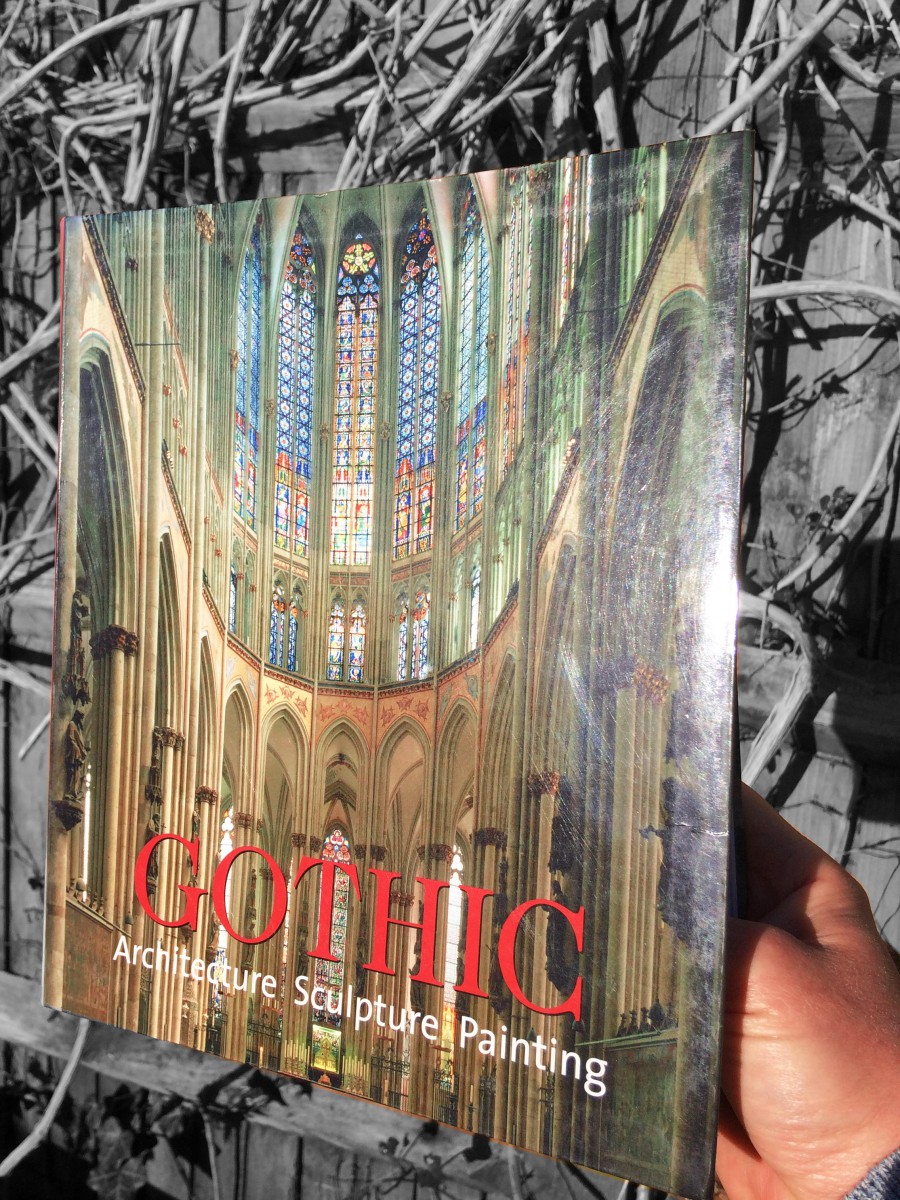
This book has been a great resource that helped me better understand the Gothic movement in art from the 12th century to the Renaissance. An architectural style that first originated in France and spread all over Europe.
Over 500 pages, it focuses on the development of Gothic architecture with many illustrations and photographs, but not only. I’ve also found the in-depth discussion of the most diverse art forms, including painting, sculpture, metalwork and even book illumination, interesting! It also includes specific coverage of the Cathars’ Heresy and the Papal Palace in Avignon. And, of course, it mentions the cathedral of Notre-Dame de Paris!
This is the book I recommend if – like me – you love everything about Gothic such as churches, gargoyles, stained glass, flying buttresses, and so much more.
Place du Parvis and the façade of Notre-Dame
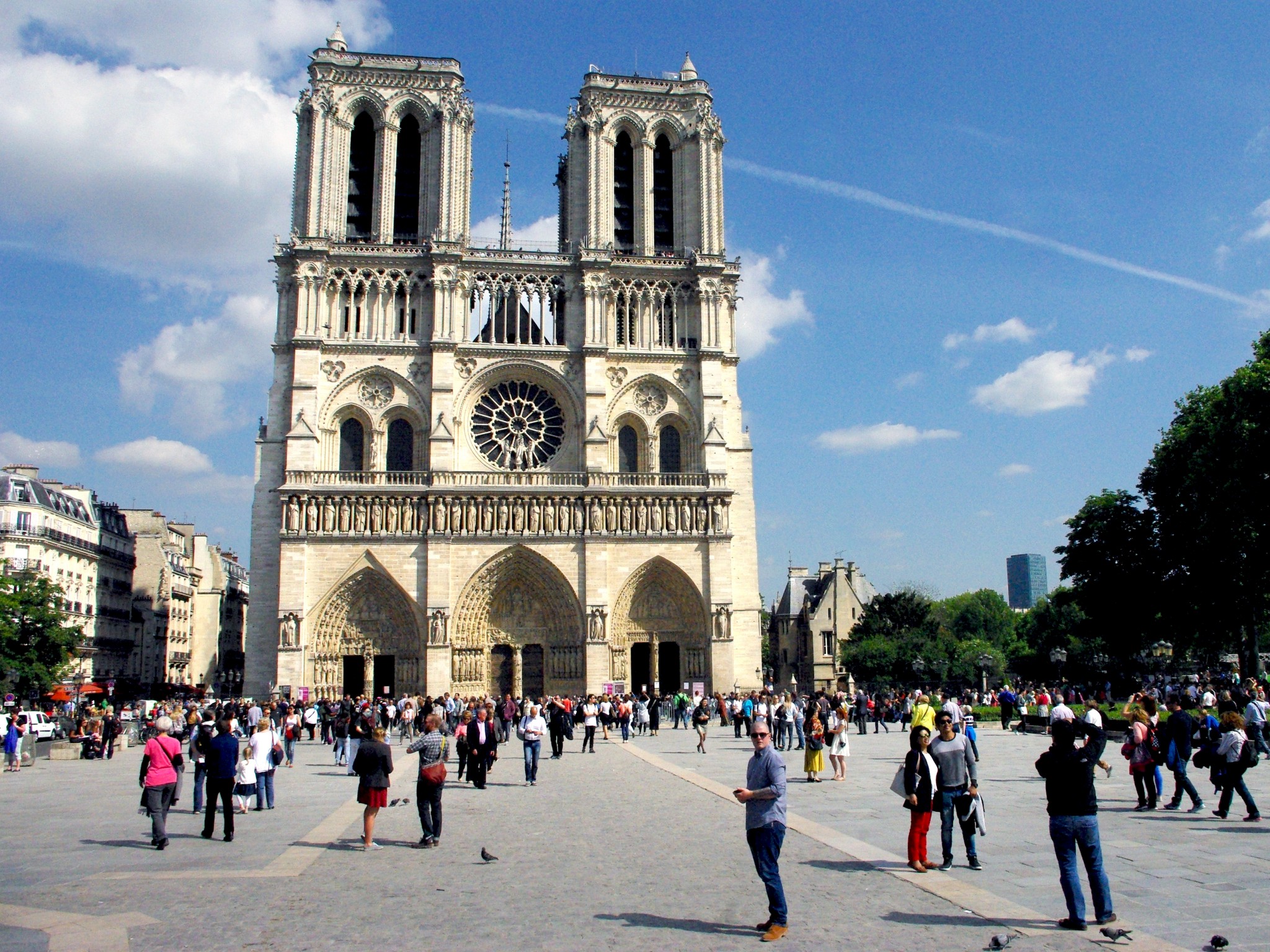
The impressive Place du Parvis is located near the entrance of Notre-Dame. In the second half of the 19th century, Baron Haussmann extended the square to make the cathedral’s presence even more remarkable.

Today we can see traces of the old road that led to the entrance of Notre-Dame, with its borders marked in different coloured stones. The Place du Parvis leads to the cathedral’s portals, which are (from left to right):
- Portal of the Last Judgement,
- Portal of the Virgin,
- and Portal of Saint Anne.
All three portals are decorated with statues that evoke images of Heaven and Hell. The most famous of these is the decapitated St. Denis holding his head in his hands, which is located on the Portal of the Virgin.
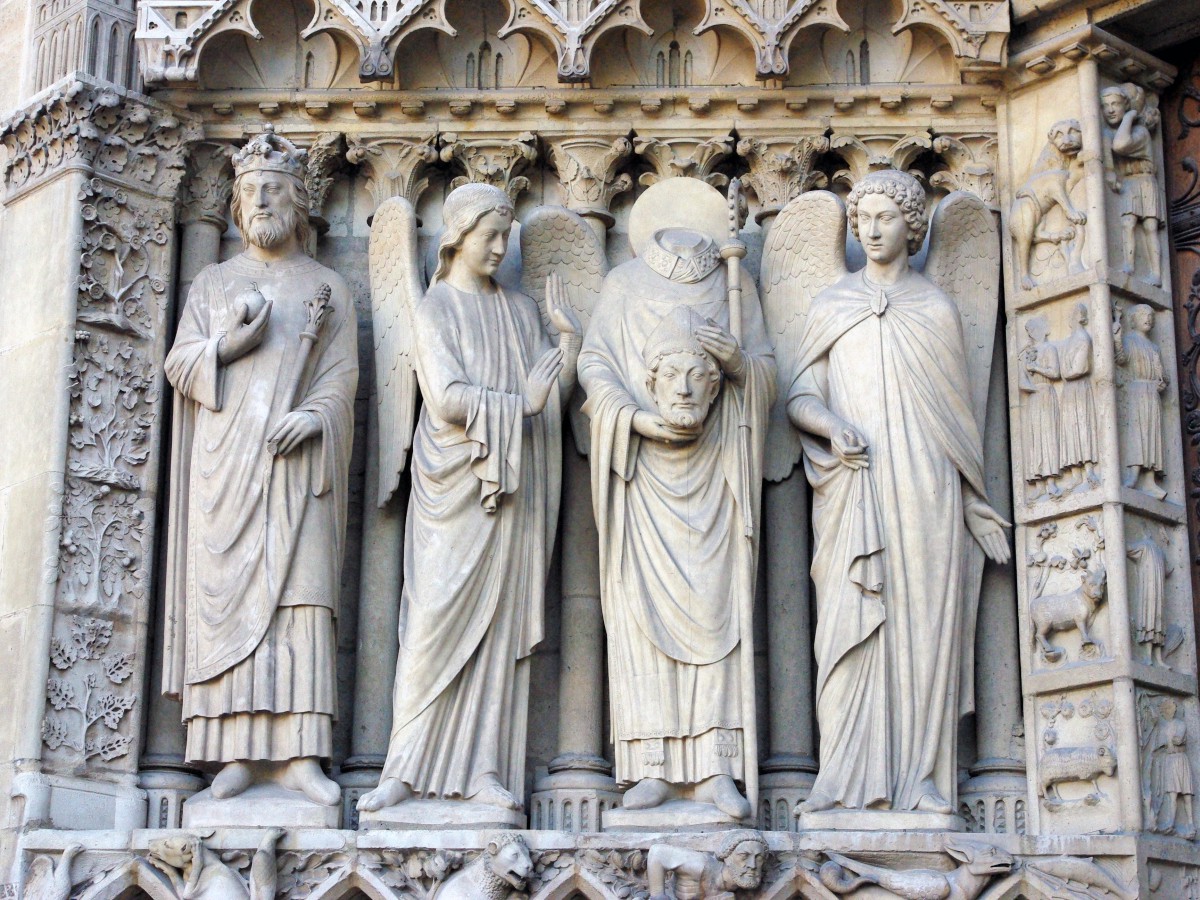
Above the portals is the Gallery of Kings. Situated 20 metres above the ground, the 28 kings represent the kings of Judah who preceded Christ. In 1793 the Revolutionaries decapitated all of these statues in response to their rejection of the monarchy. They wrongly believed that the statues represented the kings of France. Famous French architect Viollet-le-Duc had the statues restored.

Looking even higher, above the Gallery of Kings, is the balcony of the Virgin and the West rose window. This rose window forms a sort of halo behind the statue of the Virgin with the Child and the two angels.

Find out more about the West Façade of Notre-Dame Cathedral.
Climbing the Towers of Notre-Dame
We recommend starting your visit to Notre-Dame by climbing the cathedral’s towers.
The entrance to the staircase is located to the left of the North Tower on Rue du Cloître Notre-Dame. During the climb, you will come across a Gothic room that houses a souvenir shop, and after several steps, you will reach the famous Grande Galerie.

Not to be missed, this spot is the best viewpoint from which to observe:
- the frightening chimeras that keep constant watch over the cathedral, as well as
- the remarkable neo-Gothic spire that Viollet-le-Duc edified during the cathedral’s restoration in 1845.
- The gargoyles at the ends of Notre-Dame have the critical function of draining rainwater off the cathedral’s roof.
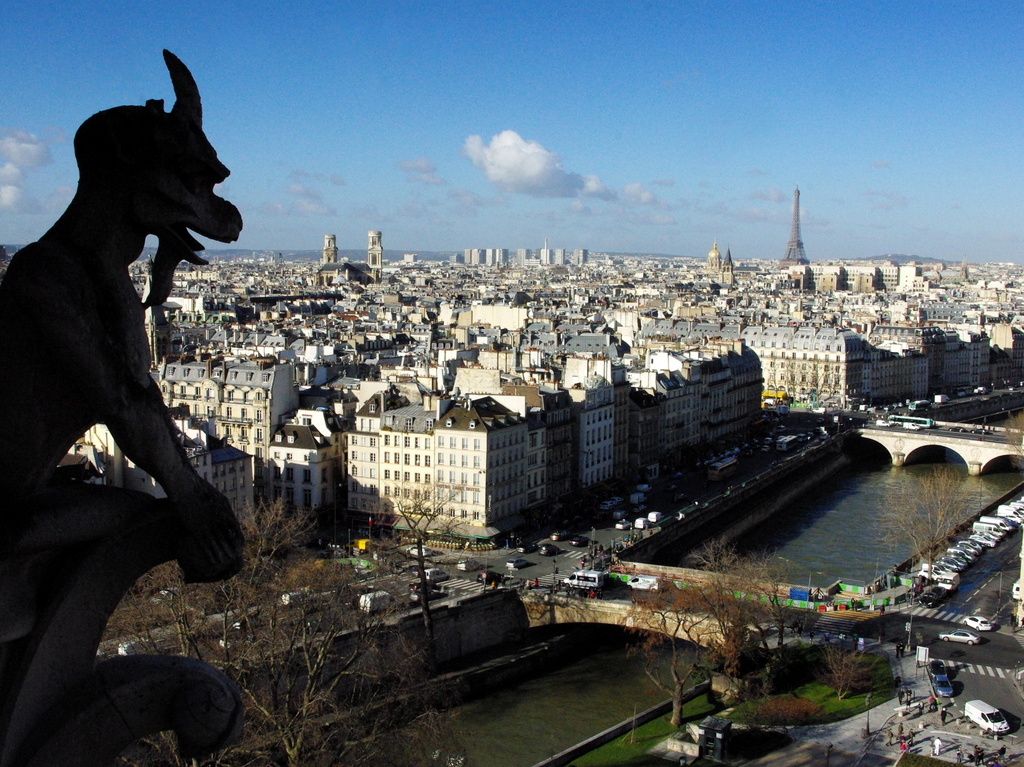
The peculiar length of the gargoyles allows them to direct the rainwater away from the façade to avoid damaging the building. All of the current gargoyles are originals from the Middle Ages.
The chimeras are decorative statues of fantastical animals and monsters. They are the addition of Viollet-le-Duc, who wanted to recreate the mystical atmosphere of the Middle Ages in Notre-Dame. You’ll find the chimeras all along the Grande Galerie.

Victor Hugo’s Notre-Dame
The story of hunchback Quasimodo attracted a lot of attention from the people when Victor Hugo’s novel was published in 1831. As such, the success of ‘Notre-Dame de Paris’ was such that the cathedral could be saved from ruin thanks to the people’s enthusiasm. Notre-Dame’s fame is thus in part thanks to Victor Hugo.
The tour group then crosses the Grande Galerie between the two towers to visit Emmanuel, the bell in the South Tower. To see Emmanuel, you have to climb the wooden stairs reminiscent of the world of Quasimodo.
Legend has it that when Emmanuel was created in 1631, the Parisians threw their jewels and gold into the molten metal. Thanks to these jewels, Emmanuel sounds a pure F. Fortunately, Emmanuel was saved during the Revolution, and the bell still tolls today on important historical dates in France and on religious holidays such as Christmas and Easter. Emmanuel weighs 13 tonnes, with its single clapper weighing 500 kilograms alone!
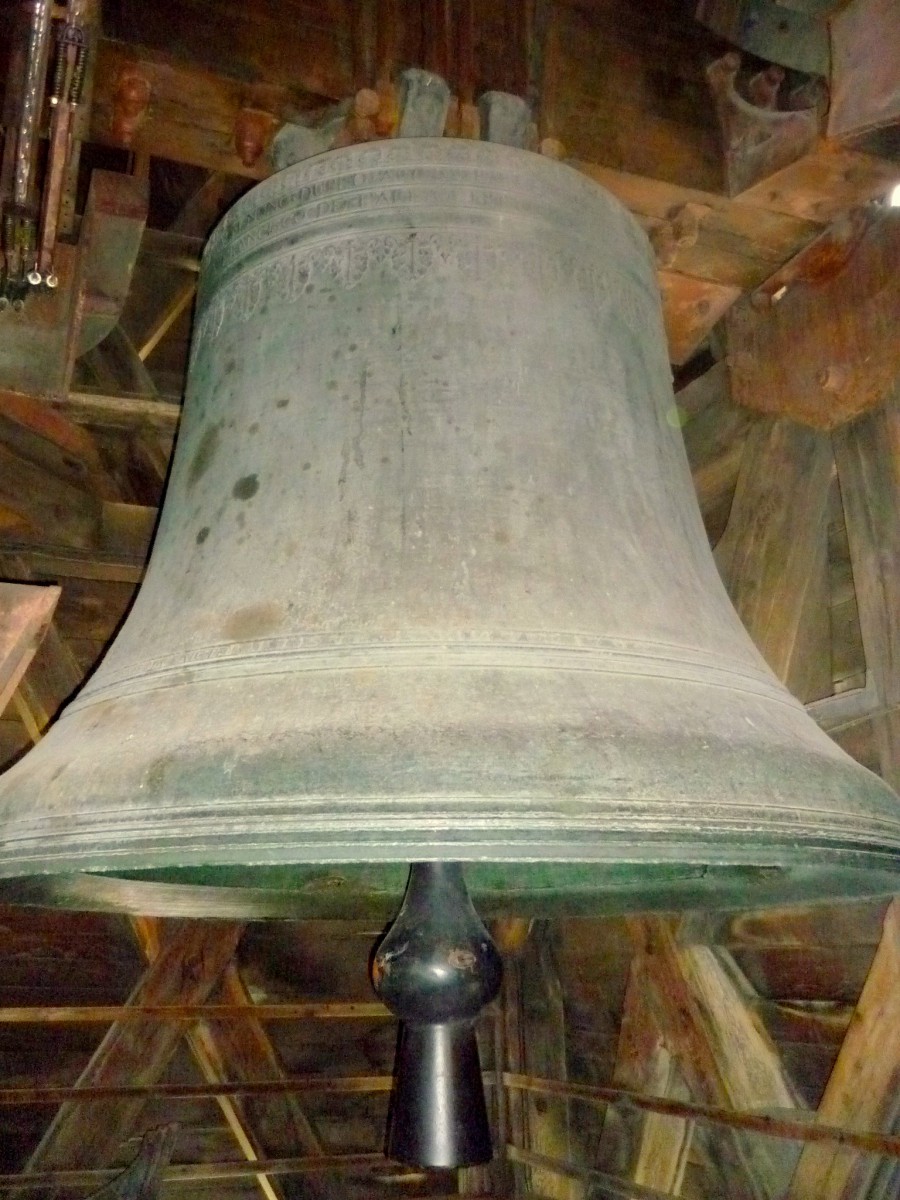
The South Tower
To take the stairs to the top of the South Tower, you must return to the Grande Galerie. At 69 metres high, you should stay as long as the guards will let you fully appreciate the magnificent view over West Paris (from the Eiffel Tower to Sacré Coeur).
This extraordinary view also provides a different perspective of the cathedral’s greenish roof, clocks, and gargoyles.


Find out more about the Towers of Notre-Dame.
Interior of Notre-Dame de Paris

The cathedral’s interior is as grand as the exterior. Notre-Dame Cathedral reveals itself by discovering its nave, side aisles, transept, choir and ambulatory.
The Nave
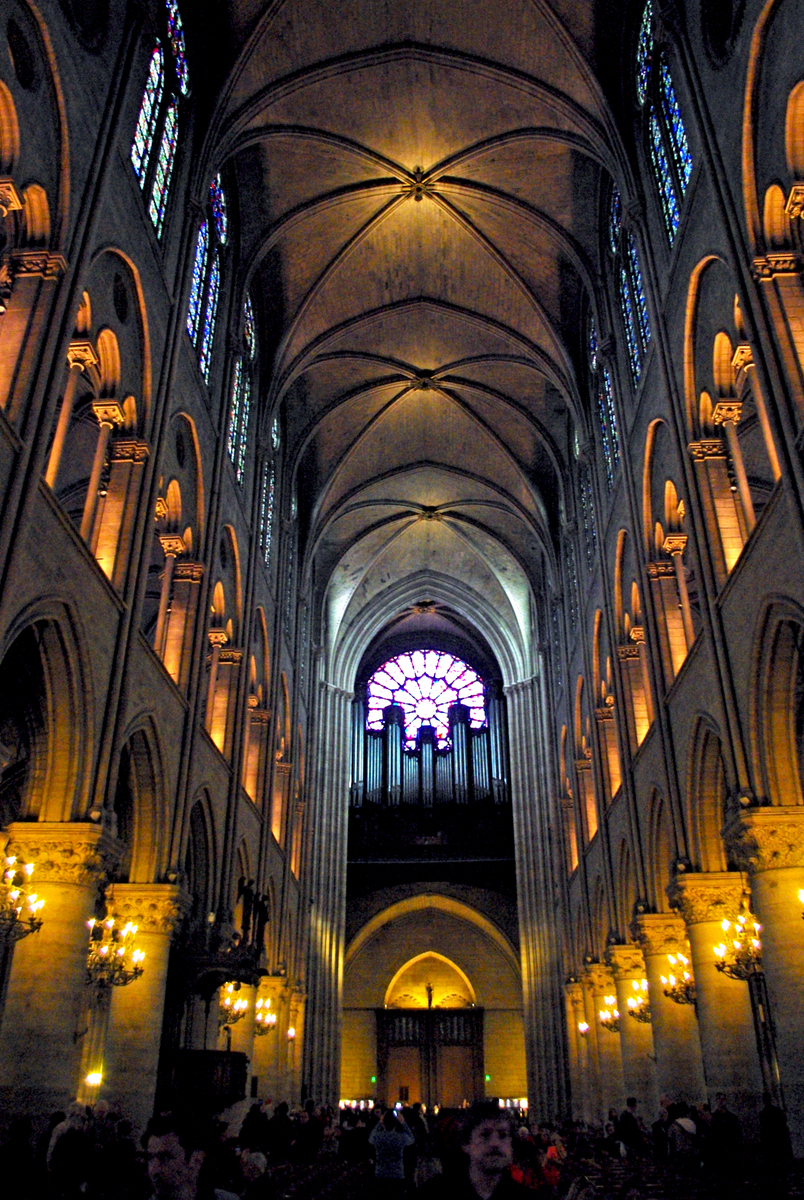
Visitors are struck by the sheer majesty of the immense nave, which accommodates 6,500 people. The nave reaches a height of 35 metres.
Ridged vaults support the ceilings, with multiple arches that come together at various points across the length of the building, covering more than 130 metres altogether.

The Chapels

We recommend touring the cathedral in a clockwise direction. The chapels surrounding the cathedral are all unique, and frescos cover their walls depicting biblical stories, most of which date from the 17th century.
These paintings have a lavishly detailed style, vibrant and gilded colours, glorifying Saints and religious characters.
There are 27 chapels, all ordered by families of the nobility and powerful corporations.
When you reach the transept, we recommend you stand at its crossing so that you can see both the North and South rose windows.
The Transept

The transept is flanked by a statue of Saint-Denis and the Virgin with Child from the 14th century. A commemorative plaque in memory of the English soldiers killed during the First World War is in the southwest. Notre Dame’s transept and crossing give the cathedral the shape of a Latin cross, which is oriented to the southeast, towards Jerusalem. Beneath the north and south rose windows are enormous stained glass windows that allow natural, warm light to permeate the crossing of the transept.
The transept offers the best views of the South, and North rose windows.
The Rose Windows of the Transept
The North rose window:
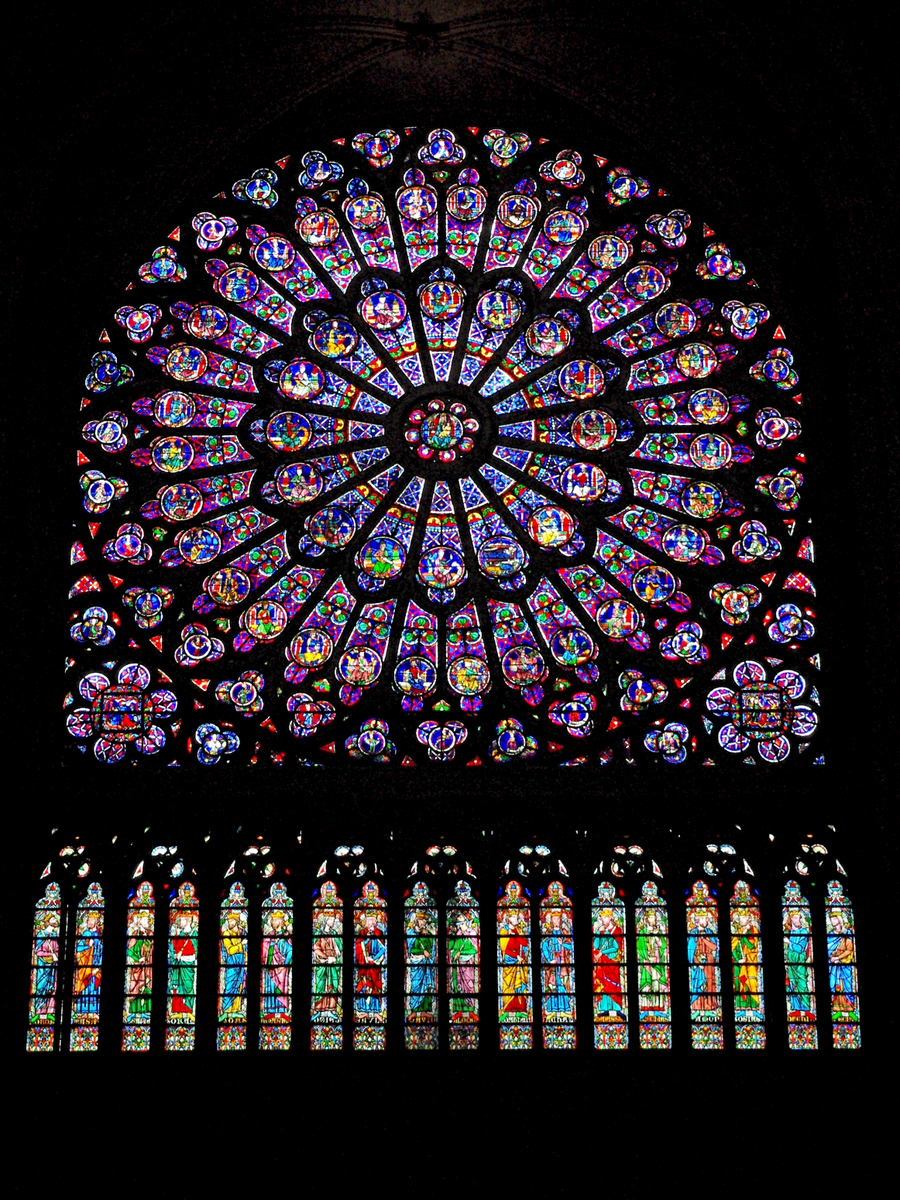
Unlike the South rose window, the North window has maintained nearly all of its original stained glass windows from the 13th century. The centre features the Virgin Mary surrounded by judges, kings, great priests and the prophets of the Old Testament.
The South rose window:
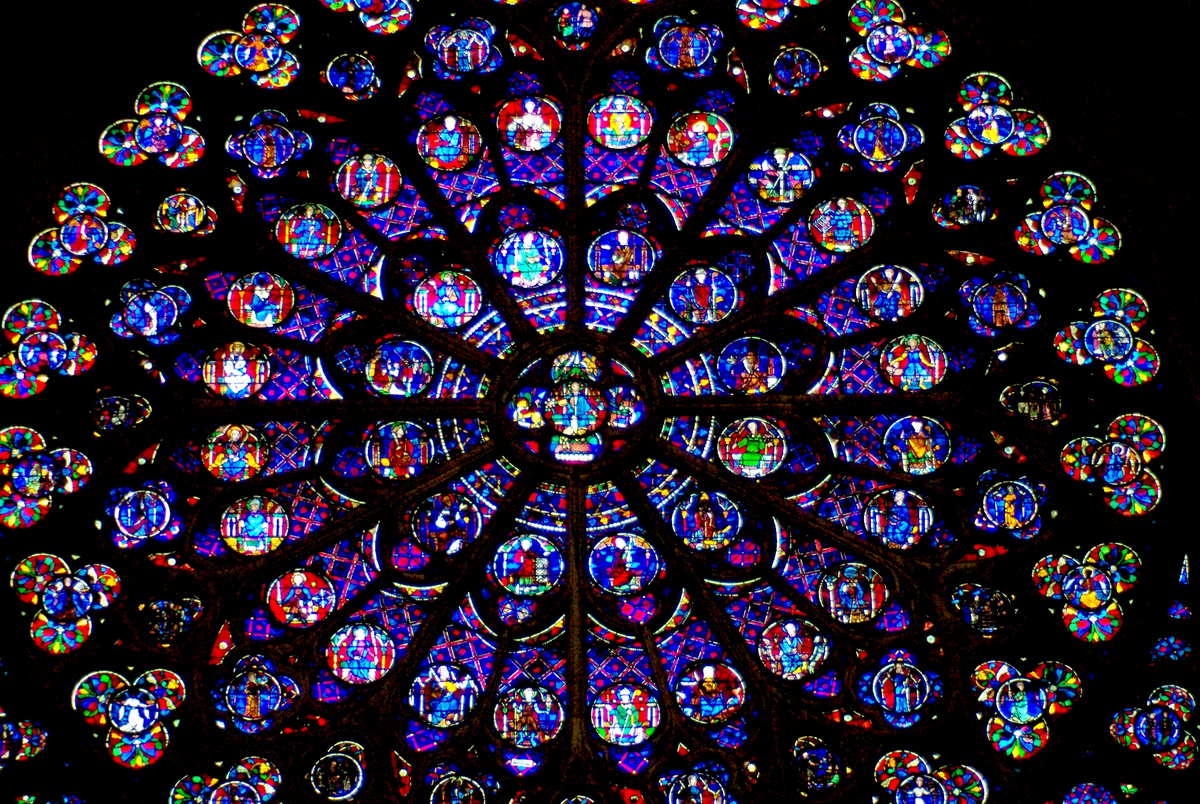
The magnificent South rose window endured the Revolution, various fires and wars. Its original stained glass windows no longer exist but were replaced by Viollet-le-Duc from 1845 onwards. They depict Jesus in the centre of the window, surrounded by saints, apostles and angels.
The Choir

Behind the transept is the choir. A double ambulatory surrounds it with a Gothic rood screen. This jube separated the sanctified area reserved for the clergy on one side and the space used by the non-religious on the other. In the Middle Ages, the nave of some Gothic cathedrals often housed a kind of covered market for merchants and their clientele. It sometimes housed the rather unusual smells of animals, urine or faeces – remembering that prostitutes offered their services in the corners of the nave!
Several Bishops and Archbishops are buried in the choir’s chapels, which are much more lavishly decorated than those found in the nave. Most of the frescos depict Jesus’ life. The choir features gilded stalls designed for the church choirs who sing hymns at services and religious celebrations.
The Stained-Glass Windows

Notre Dame’s stained glass windows depict religious stories. The two world wars destroyed some windows dating back to the Middle Ages. These windows are a testament to Gothic art’s remarkable elegance and finesse.
The Chandeliers

The chandeliers surrounding the ambulatory are located at the entrance to the chapels and are an important religious symbol, as they represent the light of God. Known as “Crowns of Light” during the Middle Ages, they were significant in churches and cathedrals.
The Great Organ

Notre-Dame’s great organ – still there today – is located in front of the large rose window of the facade and was extended in 1992. The original organ was installed in Notre Dame during the Middle Ages (12th century), but its musical capacity was no longer enough for the cathedral. The contemporary organ features five keyboards, one hundred nine stops, and almost eight thousand pipes. According to the Notre-Dame website, it is France’s largest organ.
The Buttresses and the Chevet of Notre-Dame de Paris
After a long and informative exploration of Notre-Dame, we recommend finishing your visit with a tour of the area outside the building, passing through the gardens that line the Seine.
The Buttresses

Notre-Dame’s impressive buttresses are visible on the outside of the Eastern facade. The view from Jean XXIII Square allows visitors to appreciate how the buttresses, stained glass windows and the spire complement each other beneath the shape of the dome.
These masonry arches take the lateral thrust of the archways of the groined vaults and transport them towards the abutment pillar. The pillars’ pinnacles are extraordinary and often very extravagant. Even though they appear to play a purely decorative role with their beautiful flowers, these pieces of stone or lead have the essential and practical function of stabilisation by giving extra weight to the buttresses.
Until the cathedral Saint-Etienne de Bourges was constructed, the buttresses were made up of only one giant piece. It was in Bourges that the buttress became one of the main characteristics of Gothic architecture, and this aspect of the architecture and construction gives the impression that the cathedral is suspended from Heaven.
Square Jean XXIII
By the chevet of Notre-Dame extends the Square Jean XXIII. This peaceful park features a neo-Gothic fountain and remarkable trees.

With any luck, you will be able to listen to a jazz group while you explore. Heading towards Ile St Louis, the jazz music will greet you again at the junction of the Square de Ile-de-France (used as a morgue and a walking area from the Haussmann era until 1914!) and the pedestrian-only Pont St Louis (St Louis Bridge). Your next step will undoubtedly be a well-earned rest at the Berthillon ice creamery on Ile St Louis!
Christmas at Notre-Dame de Paris
One of the most famous Nativity Scenes in Paris is found inside the Notre-Dame cathedral and attracts thousands of visitors from the first Sunday of Advent to Candlemas. Find out more about the Nativity Scene at Notre-Dame Cathedral.
Another simple Nativity Scene is set under the leading portal of Notre-Dame:

Tradition has it that a great Christmas tree stands before Notre-Dame every year.

Check out the official website of Notre-Dame for more practical info (opening times, masses…).
Pin it for later:




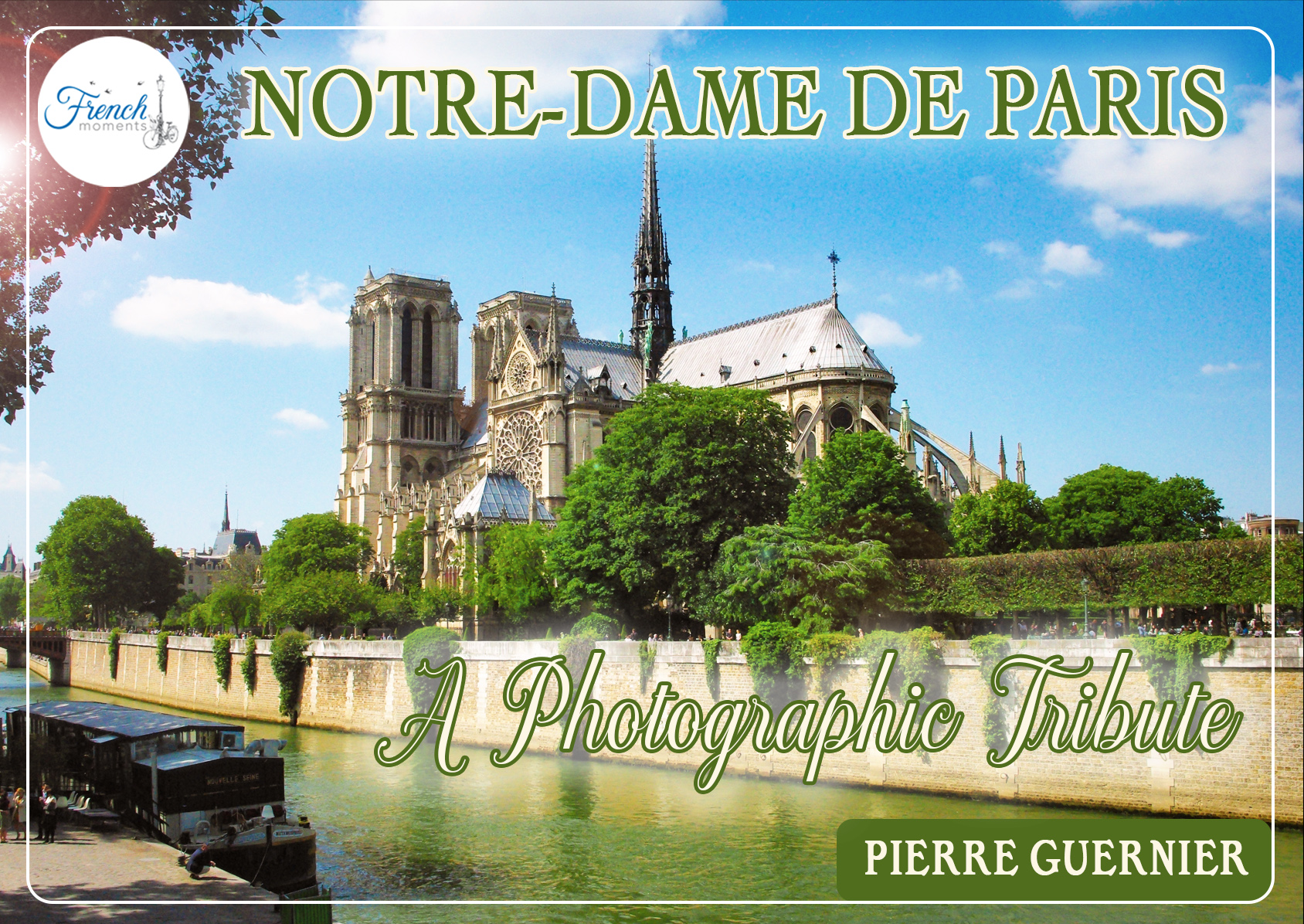


Notre Dame grew and changed many times over the centuries. Because of the fire, our generation will have the opportunity to put our mark on this magnificent cathedral. I am all in favor of adding a 21st century aesthetic to live in harmony with earlier contributions to Notre Dame’s beauty. Let’s not forget the outcry over how the Louvre’s pyramid was going to defile the beauty of the space. Cities, spaces, monuments, and even cathedrals reflect both their history and the current time. Notre Dame will come out even stronger, more beautiful and more beloved after this catastrophe. It is a testament to humankind.
Notre Dame is France and will be restored, I have no doubt. A part of me thinks that Notre Dame should be built exactly as it was and yet I also at the same time, think some contemporary touches to it should be done. I think incorporating some 21st century aspects to the Cathedral would be fine, as long as it didn’t go too far. Some changes would be fine but I prefer the traditional historical look overall.
To me Notre Dame is a place of worship for Catholics. It was built to worship, honor and glorify God. It was God’s house. It was not built as a a museum or a tourist attraction. It should be restored as it was — for the Glory of God and not for the ego of artists and man. The final decision should rest with Catholics of Paris — the clergy and the Catholic people.
Yes, the cathedral has been a monument to the glory of God since its construction… however there is an interesting thing to note about that Notre-Dame. The church is in fact a national monument owned by the French State since the 9th of December 1905. On that day a new legislation was passed, known as the law on the Separation of the Churches and State. It established that the Catholic Church became the designated beneficiary and were able to use the cathedral exclusively to practise the religion. In addition, the archbishop was responsible for paying Notre-Dame’s employees and letting it open for people to visit for free.
I have been to Paris 16 times and have visited Notre Dame at least once on every trip and introduced several friends to the cathedral. I have loved Notre Dame for years and it is my favorite Gothic Cathedral ever. I would hope that it will not be turned into a 21st century anything. There is no need to put our century’s slickness on medieval perfection. Do not mess with this Gothic Marvel. I am not sure if I would continue to visit a modernized experience,
Thank you Merle… maybe the renovation plans of Notre-Dame’s interior won’t be too different from what it used to be. We’ll have to wait until 2024 to know it for sure! 🙂
I wonder: in the far future, if a new Victor Hugo wrote a new “Notre-Dame of Paris”, would he be also lamenting its despoliation in the 21st century as the original author and the book lament its earlier despoliation?
Very good point! 🙂
I enjoyed your updated article about Notre Dame and hope to check out your book recommendation. These are exciting times in Paris (aren’t they all?!? 🤙🏽) as so many labor to restore the cathedral. In that vein, I recently watched a 2022 BBC documentary about those efforts. Perhaps you have already seen it. If not, I recommend it, as it is a fascinating and inspiring account of the work and some discoveries that have come to light.
Enjoy France!
https://youtu.be/Hw2NPzHhVfQ
Thank you very much, Greg, for your comment and the video link! I will have a look at it. Have a nice day 👋
Hello, do you know where the Crown of Thorns is now, during the restoration? Is it on view for the public, in a different location or museum, I suppose?
Bonjour! During the fire at Notre Dame, the crown of thorns was saved by a human chain and put undercover in the town hall. The relic was then placed in the Louvre, where it is still today.